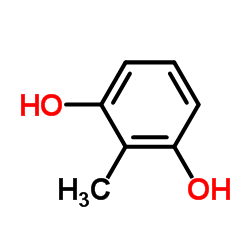2-methylresorcinol

2-methylresorcinol structure
|
Common Name | 2-methylresorcinol | ||
|---|---|---|---|---|
| CAS Number | 608-25-3 | Molecular Weight | 124.137 | |
| Density | 1.2±0.1 g/cm3 | Boiling Point | 282.1±7.0 °C at 760 mmHg | |
| Molecular Formula | C7H8O2 | Melting Point | 114-120 °C(lit.) | |
| MSDS | Chinese USA | Flash Point | 142.9±12.8 °C | |
| Symbol |

GHS06 |
Signal Word | Danger | |
|
Cross-elicitation responses to 2-methoxymethyl-p-phenylenediamine under hair dye use conditions in p-phenylenediamine-allergic individuals.
Br. J. Dermatol. 172(4) , 976-80, (2015) The factors influencing elicitation responses in individuals allergic to p-phenylenediamine (PPD) in hair dyes are not well understood.Investigation of the elicitation response to the new, less-sensitizing PPD alternative 2-methoxymethyl-p-phenylenediamine (M... |
|
|
Expanding cavitand chemistry: the preparation and characterization of [n]cavitands with n>=4.
Chemistry 7(8) , 1637-45, (2001) The preparation of cavitands composed of 4, 5, 6, and 7 aromatic subunits ([n]cavitands, n=4-7) is described. The simple, two-step synthetic procedure utilized readily available starting materials (2-methylresorcinol and diethoxymethane). The two cavitand pro... |
|
|
[Long-term preservation of DNA in aqueous solutions in the presence of the chemical analogues of microbial autoregulators].
Mikrobiologiia 75(5) , 662-9, (2006) The fact of long-term preservation of the physicochemical properties of DNA molecules in aqueous solutions in complexes with methylresorcinol, hexylresorcinol, and tyrosol, the chemical analogues of microbial autoregulators (d1 factors) from the group of alky... |
|
|
[Influence of chemical analogues of microbial autoregulators on the sensitivity of DNA to UV radiation].
Mikrobiologiia 75(5) , 654-61, (2006) We established that chemical analogues of alkylhydroxybenzenes (AHB), belonging to alkylresorcinols and functioning as microbial autoregulatory d1 factors, enhance the UV resistance of various DNA molecules of different origin and conformation. These include ... |
|
|
A subchronic, teratologic, and dominant lethal study of 2-methylresorcinol in rats. II. Teratologic and dominant lethal study.
Fundam. Appl. Toxicol. 7(2) , 293-8, (1986) 2-Methylresorcinol (2-MR) was administered to groups of 40 male and 35 female Sprague-Dawley rats by admixture with the diets at levels of 0.1, 0.4, and 1.5% (see Part I; T.H. Re, R.F. Loehr, S.C. Rodriguez, C.E. Gilmore, and C.M. Burnett, 1986, Fundam. Appl.... |
|
|
A subchronic, teratologic, and dominant lethal study of 2-methylresorcinol in rats. I. Subchronic toxicity.
Fundam. Appl. Toxicol. 7(2) , 287-92, (1986) 2-methylresorcinol (2-MR) was administered to groups of 40 male and 35 female Sprague-Dawley rats by admixture with diets at levels of 0.1, 0.4, and 1.5% for periods up to 6 months. Methemoglobin levels were determined after 6 weeks. After 90 days 10 animals/... |
|
|
A novel Helicosporium isolate and its antimicrobial and cytotoxic pigment.
J. Microbiol. Biotechnol. 22(9) , 1214-7, (2012) One Helicosporium strain, isolated from a wilted chestnut tree, evidenced in vitro antimicrobial activity against various types of bacteria and fungi, and generated a diffusible pigment. The antimicrobial compounds and the diffusible pigment of the Helicospor... |
|
|
2-Alkenal-scavenging ability of m-diphenols.
Food Chem. 160 , 118-26, (2014) The reaction between m-diphenols (resorcinol, 2-methylresorcinol, 2,5-dimethylresorcinol, 3-methylphenol, orcinol, and phloroglucinol) and 2-alkenals (2-pentenal and 2-octenal) was studied in an attempt to understand the chemical pathways involved in the scav... |
|
|
Synthesis of a series of aromatic benziporphyrins and heteroanalogues via tripyrrane-like intermediates derived from resorcinol and 2-methylresorcinol.
J. Org. Chem. 76(15) , 6295-308, (2011) Tripyrrane analogues were prepared by reacting resorcinol or 2-methylresorcinol with 2 equiv of an acetoxymethylpyrrole in the presence of p-toluenesulfonic acid and calcium chloride. Following removal of the benzyl ester protective groups, the resorcinol-der... |
|
|
Preparation of tripyrrane analogues from resorcinol and 2-methylresorcinol for applications in the synthesis of new benziporphyrin systems.
Chem. Commun. (Camb.) (2) , 178-9, (2004) Acid catalyzed condensation of resorcinol or 2-methylresorcinol with 2 equiv. of an acetoxymethylpyrrole gave bis(pyrrolylmethyl)benzene derivatives in moderate yields; these afforded a series of novel aromatic benziporphyrins using the MacDonald "3 + 1" meth... |